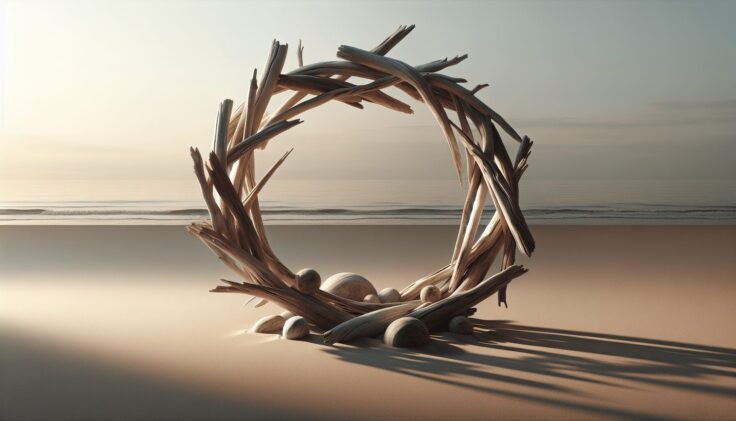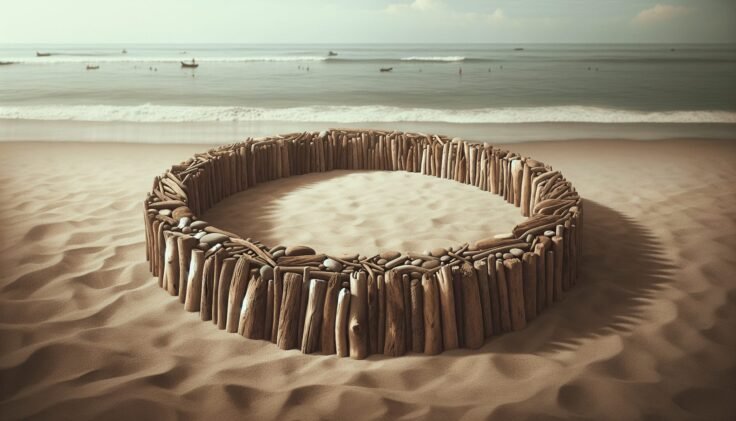Have you ever stumbled across a driftwood circle on a walk along the beach and wondered about its story? These intriguing formations have captivated the imagination of beach-goers for generations. They are often seen as places of serenity and mystery, combining the natural beauty of the sea with a touch of human creativity. In this article, we’ll explore the origins, meanings, and artistic inspiration behind driftwood circles, giving you a deeper appreciation for these unique seaside structures.
What is a Driftwood Circle?
A driftwood circle is a formation created using pieces of driftwood arranged in a circular shape. These structures are usually found on beaches, crafted by individuals or groups who are inspired by the natural elements they encounter. The circle can vary greatly in size, from a small personal installation to a large, collective art project that encourages the participation of passersby.
Characteristics of Driftwood
Before discussing the circle itself, it’s important to understand the main material—driftwood. Driftwood refers to wood that has been washed ashore by the action of winds, tides, or waves. Over time, the wood becomes weathered and smooth, acquiring a distinctive, bleached appearance. Driftwood can come from various sources, such as fallen trees, broken branches, or even lumber that has been discarded.
The Artistic Aspect
The artistic appeal of driftwood circles lies in their use of natural materials and their temporary, ever-changing nature. The pieces of wood are typically found rather than bought, lending the projects a spontaneous air and ensuring each circle is unique. Many artists and nature enthusiasts are drawn to driftwood circles for their capacity to merge art and nature, offering an opportunity to reflect on the beauty of the landscape while engaging creatively with it.
Historical Origins and Cultural Significance
Driftwood circles are not merely modern artistic creations; they hold historical significance and have been used by various cultures across the world. Understanding these cultural roots can provide a richer context for appreciating these formations.
Indigenous Practices
Some indigenous cultures have used driftwood circles as ceremonial sites or gathering places. In these traditions, the circle often represents infinity, the cycle of life, or the unity of a community. The use of driftwood adds another layer, symbolizing resilience and adaptability, as the wood has traveled and persevered to reach the shore.
Spiritual and Ritualistic Uses
Driftwood circles sometimes serve a spiritual purpose. They can be places for meditation, reflection, or rituals, offering a space that feels both connected to the Earth and protected from the distractions of daily life. The act of building or sitting within a driftwood circle can facilitate a sense of peace and connection with nature.

Building a Driftwood Circle
Creating your own driftwood circle can be a rewarding project, allowing you to engage directly with the environment while expressing your creativity.
Locating the Right Spot
Choosing the right location is crucial for your driftwood circle. A spot that is serene and receives a steady supply of driftwood is ideal. Ensure you respect local guidelines about the use of natural materials and the creation of structures on public land.
Collecting Driftwood
Only collect pieces of driftwood that have naturally washed ashore, ensuring your activity is environmentally friendly. Look for pieces that have interesting shapes or textures, as these will add character to your circle.
Designing Your Circle
You can arrange the driftwood in various ways to reflect your personal vision. Whether you prefer a tightly arranged circle or a more loosely defined pattern, take your time to experiment with different layouts. Remember that this is a transient installation, subject to the whims of the weather, and enjoy the process of creation.
Driftwood Circles in Art and Literature
Throughout history, driftwood circles have made their mark not only physically but also culturally, inspiring numerous works of art and literature.
Inspirations and Representations
Many artists take inspiration from driftwood circles to explore themes of nature, time, and human interaction with the environment. Painters, photographers, and sculptors have all sought to capture the essence of these formations in their work.
Example: Artists might use driftwood circles to symbolize the impermanence of nature or to highlight the beauty found in random, natural arrangements.
Literary Mentions
In literature, driftwood circles often appear as metaphors for life’s cycles and the interconnectedness of all living things. Writers may use them to set a scene of contemplation, where characters grapple with personal or existential dilemmas.
Table of References
| Field | Notable Works/Inspiration |
|---|---|
| Art | Installations by environmental artists |
| Photography | Seaside collections capturing transient beauty |
| Literature | Novels and poetry focusing on nature’s cycles |

Environmental Considerations
While driftwood circles are a beautiful form of expression, it’s important to consider their impact on the environment.
Sustainable Practices
To ensure that your appreciation of driftwood circles remains environmentally conscientious, follow best practices such as collecting only naturally washed-up wood and dismantling your circle after a certain period, so that the wood can return to its natural cycle.
Impact of Removal
Removing too much driftwood from a single location can disrupt local ecosystems, as it serves important roles such as providing habitat and preventing erosion. Be mindful and take only what you need for your project.
The Community Connection
Driftwood circles often become focal points for community interaction. People are naturally drawn to these formations, sparking conversations and encouraging cooperative creativity.
Group Projects
Organizing a community driftwood circle-building event can foster collaboration and environmental awareness. Participants can share ideas, discuss the symbolism of the circle, and enjoy a shared experience in nature.
Social Media Influence
The rise of social media has amplified the visibility of driftwood circles, with people sharing photos and their experiences of these unique structures. Platforms like Instagram and Pinterest are filled with beautiful imagery, which in turn inspires others to create their own versions.
Symbolism and Personal Reflection
Driftwood circles offer a rich tapestry of symbolic meaning, which can be deeply personal and emotionally resonant.
Themes of Connection
The circle shape itself has universal interpretations such as eternity, inclusiveness, and unity. When combined with driftwood—each piece with its own history and journey—the circle becomes a powerful symbol of interconnected life paths.
A Personal Space
For many, a driftwood circle can act as a personal sanctuary, a place to sit in peace and reflect on life’s broader questions or simply enjoy a moment of mindfulness. The meditative act of arranging the driftwood, or just observing its form, can be a profoundly grounding experience.
Conclusion
To walk upon a driftwood circle is to encounter the intersection of nature, art, and human expression. Whether you are inspired to create your own, explore the cultural and spiritual histories, or simply admire their fleeting beauty, driftwood circles offer a unique opportunity to connect with the world around you. Next time you find yourself on a beach, consider the stories told by these elegant formations—they are a humble yet powerful reminder of the harmony we can find in nature.